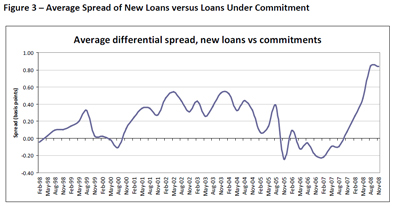The Bank for International Settlements has released its Annual Report 2008-09; some of the policy recommendations are contentious!
One interesting reference is:
Moreover, managers of assets in a given asset class were rewarded for performance exceeding benchmarks representing average performance in that investment category. As a result, even if managers recognised a bubble in the price of some asset, they could not take advantage of that knowledge by selling short for fear that investors would withdraw funds. The result was herding that caused arbitrage to fail.
Footnote: For a discussion of how arbitrage fails when individual investors cannot distinguish good asset managers from bad ones, see J Stein, “Why are most funds open-end? Competition and the limits of arbitrage”, Quarterly Journal of Economics, vol 120, no 1, February 2005, pp 247–72.
I’ll have to read that reference sometime!
The regulators continue to deflect blame for the crisis onto the Credit Rating Agencies:
In the end, the rating agencies– assigned the task of assessing the risk of fixed income securities and thus of guarding collective safety – became overwhelmed and, by issuing unrealistically high ratings, inadvertently contributed to the build-up of systemic risk.
Footnote: Differences in the methodologies used by the rating agencies also provided incentives for the originators to structure their asset-backed securities in ways that would allow them to “shop” for the best available combination of ratings (across both rating agencies and the liabilities structure of those instruments). See I Fender and J Kiff, “CDO rating methodology: some thoughts on model risk and its implications”, BIS Working Papers, no 163, November 2004.
Which is, of course, self-serving nonsense. It is the regulators who have been assigned the task of guarding collective safety. CRAs merely publish their opinions, the same way I do and the same way any idiot with access to the internet can do. As discussed by researchers at the Boston Fed in Making Sense of the Sub-Prime Crisis (which has been discussed on PrefBlog), the tail risk of sub-prime securities was well-known, well-publicized and ignored.
And as for their observation that:
And because of the complexity of the instruments, reliance on ratings increased even among the most sophisticated institutional investors.
… well, if I don’t understand something and can’t understand how to model it, I don’t buy it. I guess that makes me the most sophisticated investor in the world.
They do make one sensible observation:
Finally, there were governance problems in risk management practices. For both structural and behavioural reasons, senior managers and board members were neither asking the right questions nor listening to the right people. The structural problem was that risk officers did not have sufficient day-to-day contact with top decision-makers, often because they did not have sufficiently senior positions in their organisations. Without support from top management, it didn’t matter much what the chief risk officer said or to whom he or she said it. The structural problem was compounded by the behavioural response to a risk officer whose job it is to tell people to limit or stop what they are doing. If what they are doing is profitable, it is going to be difficult to get managers and directors to listen.
However, I don’t see anything addressing the obvious corrollory that bank size must be controlled, preferrably through the imposition of progressively increasing capital requirements based on size. After all, if all the big international banks disappeared, where would an intelligent and knowledgable BIS employee look to for future employment? To achieve the desired end, it’s probably better to insist on a greater and better paid head-count in the Risk Management division.
The recommendation that has attracted the most attention (e.g., a Reuters report) is:
Balancing innovation and safety in financial instruments requires providing scope for progress while limiting the capacity of any new instrument to weaken the system as a whole. Balance can be achieved by requiring some form of product registration that limits investor access to instruments according to their degree of safety. In a scheme analogous to the hierarchy controlling the availability of pharmaceuticals, the safest securities would, like non-prescription medicines, be available for purchase by everyone; next would be financial instruments available only to those with an authorisation, like prescription drugs; another level down would be securities available in only limited amounts to pre-screened individuals and institutions, like drugs in experimental trials; and, finally, at the lowest level would be securities that are deemed illegal. A new instrument would be rated or an existing one moved to a higher category of safety only after successful tests – the analogue of clinical trials. These would combine issuance in limited quantities in the real world with simulations of how the instrument would behave under severe stress.
Such a registration and certification system creates transparency and enhances safety. But, as in the case of pharmaceutical manufacturers, there must be a mechanism for holding securities issuers accountable for the quality of what they sell. This will mean that issuers bear increased responsibility for the risk assessment of their products.
In other words, if I want to sell you a product with a complex pay-out and you want to buy it … too bad; we’ll both go to jail on charges of not being smart enough. Similarly, if I sell you an investment product and you lose money, you can get your money back from me because it is quite obvious that I sold you something you’re not smart enough to buy.
I wonder what that little change will make to the deemed capitalization of securities firms!
Update, 2009-7-2: Regulation of product types endorsed by Willem Buiter:
What I have in mind is an FDA for new financial instruments and institutions. Like new medical treatments, drugs and pharmacological concoctions, new financial instruments, products and institutions are potentially socially useful. They can also be toxic and health-threatening.




